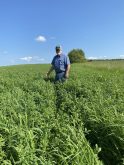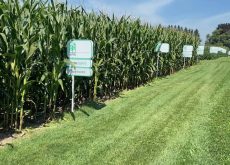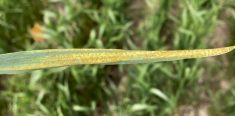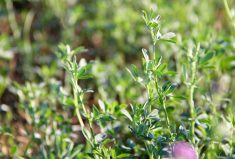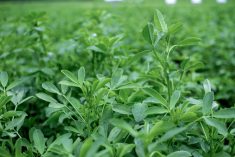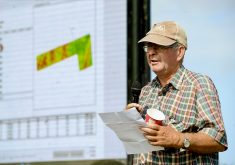Ontario-grown hay – both pure alfalfa and pure timothy – will make its way by container ship to the Middle East this summer, through the efforts of the Ontario Hay and Forage Co-operative Ltd.
That assurance was given by the organization’s chair, Fritz Trauttmansdorff, during a first-ever production information meeting recently in Mount Forest.
Why it matters: The co-operative formed in late 2015 and has been developing markets in the Middle East. However, it needs to double compact hay in order to more efficiently ship it to those markets in containers. It is hoping to build a $10-$15 million compaction facility in southern Ontario, but still needs more members.
Read Also

Conservation Authorities to be amalgamated
Ontario’s plan to amalgamate Conservation Authorities into large regional jurisdictions raises concerns that political influences will replace science-based decision-making, impacting flood management and community support.
With a smaller compactor in use in eastern Ontario, and growers on board to supply hay, Trauttmansdorff expects both alfalfa and timothy will be loaded at the Port of Montreal later this year.
As for the multi-million-dollar plans for a larger double compactor – which, Trauttmansdorff explains, can take an eight-foot-long square bale and turn it into an extremely tightly-packed four-foot-long bale – “it all depends on how good it goes this summer.”
“We need processing facilities, we need dryers, and we need markets,” said Trauttmansdorff, the chair of the co-operative. “And they’ve all got to come together for us to move forward,” he said, adding the co-op is working on accomplishing this in increments.
There are now two dryers in operation – at the Trauttmansdorff farm near Jerseyville, and at the farm of Hay and Forage Co-op director Chris Martin at Alma, who developed the dryer over the past couple of years with his brother. The dryers developed by the Martins are selling under the Chinook Hay Systems name and will cost about $200,000. Two other Co-op members are in the process of having dryers installed at their farms this year.

Trauttmansdorff hopes, eventually, there will be a dryer either at each farm or at a farm that’s central for a group of producers in a small area. Bales need to be taken down to 18 per cent moisture to be suitable for the compactor, and for export. The dryers mean that wetter hay can be harvested and dried, without leaving it at a risk of rain in the field.
Water restrictions mean growing hay demand
Securing markets, meanwhile, is an area in which the Co-op has met with some success. Trauttmansdorff travelled to China in 2016 and Dubai in 2017, and fellow Hay and Forage Co-op director Chris Riach was in Abu Dhabi earlier this year.
“The markets want either pure timothy or pure alfalfa,” he explained. In the case of the Middle East, which the Co-op aims to take advantage of this year, the timothy is either as a fibre content in dairy rations, or for horses and camels. The co-op wants to tap into the Middle East markets first because they believe there’s a huge potential opening up all at once this year, so they won’t have to force their way into an already-established market.
“What’s happening in the Middle Eastern countries is that they’re running out of water, and some of the countries have made the decision now to stop irrigating for forage products.” Irrigation will be reserved only for products grown directly for human consumption. That’s putting livestock producers – including some very large dairy operations – into scramble mode to secure feed.
A co-op director in eastern Ontario, André Larocque, has a double compaction press on farm. The co-op aims to aggregate export-quality hay from its members at locations across Ontario, transport it to the press in eastern Ontario where it will be compacted and packed in containers, then on to Montreal for export.
He suggested there has always been a healthy market for pure timothy among equine breeders in Ontario and the US. But “the timothy market internationally is very attractive right now.” He heard an estimate of US $580 per metric ton in Dubai for pure, high-quality timothy hay. They aim to pack 25 metric tons in a container.
Higher fibre, larger head timothy
Joel Bagg, forage development specialist for Quality Seeds, delivered the morning session about fertilizers, and took time at the end of his talk to specifically address timothy for export. He noted the timothy Ontario hay growers are accustomed to has been as part of mixed hay, with varieties tending towards later maturity to match the maturing rate of the alfalfa that makes up the majority of the mix. They’ve also tended towards smaller heads so the timothy is less coarse in the mix. And there hasn’t been a big focus on having it compete well against other plants because alfalfa has always been the dominant species.
Overseas markets, by contrast, put value on higher fibre content, so varieties with larger heads are preferable. Drought tolerance is important, as is early maturity – especially for a small group of Hay and Forage Co-operative members who last year launched a pilot project of growing pure timothy in a manner similar to winter wheat by planting in the fall and harvesting in late spring or early summer. The growers taking part have actually been double-cropping their fields – no-tilling soybeans after harvesting the timothy, then fall-seeding timothy on the same field following soybean harvest.
The co-op currently has about 55 members. The membership fee is a sliding scale based on the amount of hay you plan on providing to the co-op.




